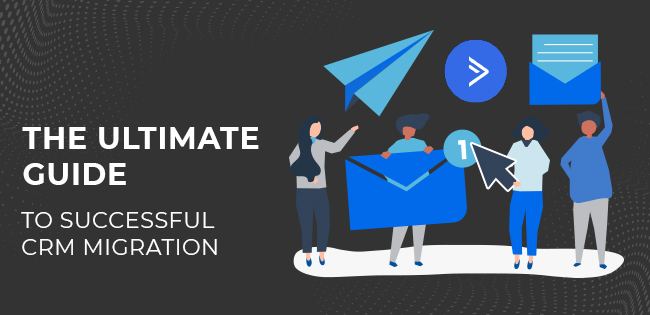CRM is a critical aspect of your business, so migrating it must be handled with care to avoid all potential risks. Here’s how you can ensure a flawless CRM migration and seamlessly improve your business.
Migrating CRM refers to transferring customer records to a different CRM platform. And it has become a standard practice to do so for companies seeking to optimise their business processes.
Successful CRM migration can help improve business efficiency, lower maintenance costs, boost performance, and make processes scalable, better integrated, and more flexible.
The reason behind CRM migrations becoming common is due to the constant evolution of CRM systems. It’s only natural for a business to want to leverage the latest developments. If you believe there’s a CRM system that would suit your needs better than the one your company’s currently using, there’s no reason not to migrate.
However, CRM migration isn’t an easy task despite all of the potential benefits. Contact data might get mixed up, lost, or worse, corrupted. Not to mention your team could have a hard time adjusting to the new circumstances. That’s why a successful CRM migration requires careful planning beforehand and proper execution beyond.
Paying attention to some crucial steps will make the migration much more straightforward. To help you perform the process as seamlessly as possible, we’ve created a comprehensive guide that will take you through all of the essentials.

9 Steps for Successful CRM Migration
Overall, the most effective way to perform CRM migration is through an API. The method involved is exceptionally effective, but not without its pitfalls. The following tips will rely on that method and help you avoid potential complications during the process.
Step #1. Prepare Your Team for the Change
It might seem obvious, but the first thing to do when preparing for a CRM migration is to ensure that the company leadership is on board with the change.
Those that make decisions in a business will have a clearer picture of both the redundant and necessary fields within the new CRM. They will also be the first to notice any shortcomings in the new system, and the quickest ones to compare it to the old.
Another aspect of preparation on the company level is convincing people to relinquish a CRM system they’ve grown accustomed to and embrace the upcoming change.
Finally, it’s best to start training your workforce before and during the migration. The sooner they develop proficiency with the new CRM system, the sooner it will become useful and efficient.
Step #2. Decide on the New CRM
From the big name CRMs to smaller services and marketing platforms, there’s a large number of available options to choose from. You’ll have to decide on one that fits your company’s needs the most.
Here are some essential considerations to take when choosing a CRM:
- How does the new CRM solve the shortfalls of the old one? Make a list of problems present in your current system and zoom in on a CRM that addresses those issues and improves on them.
- Will the new CRM require integration with additional software? If so, what software will it need to function correctly? The best way to make the transition as quick and painless as possible is to have the software logistics in place. It would be useful to find a CRM that fits with the software your business is already using.
- Companies with a limited budget will also have to consider the price. And if you’re running a small or even medium company, the cost could prove a limiting factor. If there are several pricing plans for the CRM of your choice, the more affordable options will come with certain limitations. Make sure those limitations can still fulfil the needs of your business.
- Will the new CRM be able to follow your company’s projected growth? If you’re unsure that the chosen pricing plan will keep up with the number of newly added contacts, it might be best to pick a somewhat pricier plan that will continue to serve your business for longer.
- Will your team members have a hard time learning to work with the new software? If there’s a steep learning curve, how long will it take before your company can efficiently utilise the software? This aspect is something that companies can easily overlook, but the fact is that the easier it is to use a new CRM, the sooner your business can return to regular operations.
Step #3. Analyse and Backup Your Data
A vital part of CRM migration is analysing the data contained in your old CRM. It would be best to determine which data formats are present, how the data is organised, and what exactly you want to migrate before actually doing so.
Data analysis also offers a good opportunity to remove duplicate entries that were likely overlooked. After the analysis is done, it will then be easier to create a data map for the most effective future organisation.
When everything is adequately analysed and organised, make sure to backup all valuable data before starting the migration process. No one can guarantee everything will go smoothly during the CRM migration, and you don’t want to end up losing the data due to an unforeseen error.
Step #4. Sync Your Contacts
It’s best to synchronise your contacts as soon as possible to ensure your email marketing can continue to function like before. And there are several ways to do this, depending on the platform.
You might be using a platform that has integrated sales and marketing, in which case your contacts will remain safe on it. Some examples of such platforms are HubSpot or Marketo.
Meanwhile, most CRMs will have some kind of built-in sync options. But it would be best to test how functional it is before following through with the migration.
Finally, you could opt for a third-party tool like Zapier to synchronise your contacts. We would recommend the same approach here as with the built-in options – perform extensive testing before committing to the process.
Step #5. Migrate Your Emails
Some CRMs will integrate emails in the records and migrate individual messages, making the complete communication history immediately available. Of course, this option will be invaluable for your sales team.
If you need a specialised tool to make sure the email messaging history is entirely transferred to your new CRM, there are plenty of third-party software tools that can do just that. You’ll need to research the options in detail and consider the cost, as the email migration service will likely come with a fee.
To prepare for email migration most efficiently, archive all messages from the old CRM. Also, bear in mind that messages coming from an address without a contact most likely won’t be migrated. To test for this, perform some trials with sample messages and see if any emails are left untransferred.
Step #6. Assess Data Quality
We already mentioned the importance of data analysis and how removing duplicated entries is a good idea. This is a part of the process called Data Quality Assessment.
The entire process relies on detailed data analysis and how you’ll act on it. It would help to discern what data is most important and what’s no longer useful.
Here are several crucial actions you’ll need to take while assessing the data quality:
- Determine if there are missing data entries and fill them in
- Take care of any data inconsistencies
- Locate and remove record duplicates
- Maintain the data flow
Bear in mind that preserving and optimising data is at the core of CRM migration and CRM services in general. Hence, it’s vital you make sure its quality is maintained.
Step #7. Focus on Customisation
Your old CRM likely has several custom fields and the only way to preserve the data during migration is to ensure that the new platform can substitute those fields appropriately.
It’s possible that your new CRM has all the necessary fields. In that case, you’ll have no problem with integrating and preserving the custom elements.
But if the new platform lacks the fields, you can ask your CRM migration company to add those custom elements before starting the process.
Step #8. Test Before Migrating
When it comes to such sensitive tasks as CRM migration, trials and testing are always welcome. This is to verify the functionality of the migration tools to be used, as well as the new CRM system itself.
The best method to test data migration is to choose a portion of data and transfer it. Your testing sample should comprise different data groups that get sent to various locations. Naturally, you’ll want to back up the sample before attempting the trial.
You’ll learn from the test how reliable and efficient the data migration tool is and discover any potential errors and remedy them early in the process. Once all of this is done, you should repeat the test to confirm everything is going as expected.
If there are persistent or recurring complications, you should consider a different CRM service.
Step #9. Secure the Best Migration Tool
The migration tool is arguably the most crucial technical aspect of CRM migration. Based on how complicated your data system is, it might prove quite challenging to develop such a tool.
Automatic data migration is usually handled by a script to be built by a team of professional CRM developers. They’ll need to consider the migration algorithms in detail, as well as build a mechanism for error detection sensitive enough to pick up on any mishaps.
Some specific tools required for data migration include an import wizard, SSIS, Scribe, and others.

Improving Your Business With Great New CRM
Once you’ve decided on the best CRM for your company, analysed, tested, and performed the CRM migration, it should bring a breath of fresh air into your business.
There might be some learning pains in the beginning. But with the right CRM, your efficiency will start to improve significantly.
Of course, CRM migration is a delicate and complex process and the very prospect of it might leave some people feeling reluctant. After all, your customer data is the real value behind your company.
Luckily, there’s no reason to brave the challenges all on your own. Contact Automation Agency and rest assured you’re in the right hands. Our capable Concierge Service will take care of all your CRM migration needs and make the transition seamless.
Go to this link to find out about the full range of our services and start growing your business now.


